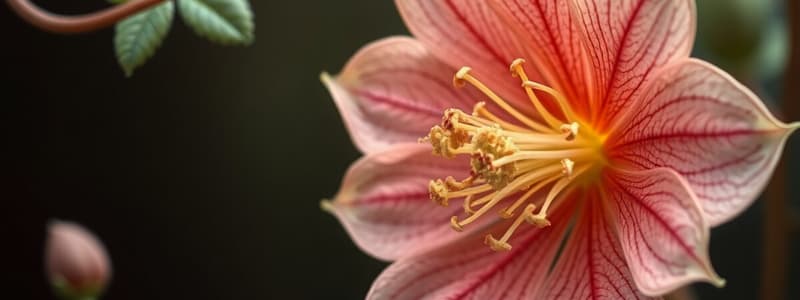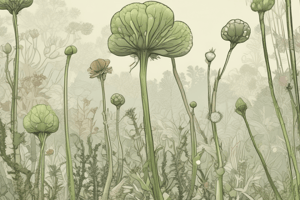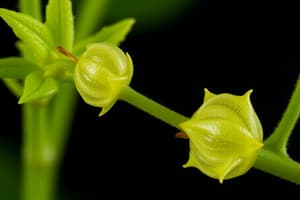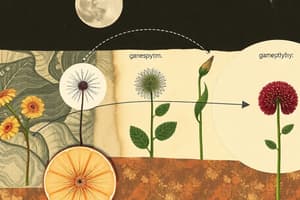Podcast
Questions and Answers
How many nuclei does the mature embryo sac contain?
How many nuclei does the mature embryo sac contain?
eight
What does the ovule become if fertilized?
What does the ovule become if fertilized?
a seed consisting of the embryo sac, megasporangium, and two integuments
Where does the male gametophyte develop?
Where does the male gametophyte develop?
pollen grains
What do microspore mother cells undergo?
What do microspore mother cells undergo?
What does each microspore undergo to form a haploid male gametophyte?
What does each microspore undergo to form a haploid male gametophyte?
What are the two cells that make up the gametophyte?
What are the two cells that make up the gametophyte?
The spore wall is produced by the microspore and the anther.
The spore wall is produced by the microspore and the anther.
The spore wall often has a unique species-specific pattern.
The spore wall often has a unique species-specific pattern.
Flashcards
What is the outcome of a fertilized ovule?
What is the outcome of a fertilized ovule?
The ovule, after fertilization, develops into a seed, composed of the embryonic sac, the megasporangium, and two protective layers called integuments.
Describe the structure of a mature embryo sac.
Describe the structure of a mature embryo sac.
The mature embryo sac contains eight nuclei within seven cells. This includes three antipodal cells with unknown function, a large central cell containing two polar nuclei, and an egg cell alongside two synergid cells.
What is a microsporangium?
What is a microsporangium?
A pollen sac is a structure within the anther where pollen grains develop.
What is the structure of the male gametophyte?
What is the structure of the male gametophyte?
Signup and view all the flashcards
How are microspores formed?
How are microspores formed?
Signup and view all the flashcards
How does a microspore develop?
How does a microspore develop?
Signup and view all the flashcards
What does the generative cell produce?
What does the generative cell produce?
Signup and view all the flashcards
What is the function of the tube cell?
What is the function of the tube cell?
Signup and view all the flashcards
What feature can help identify different plant species?
What feature can help identify different plant species?
Signup and view all the flashcards
How many pollen sacs are in an anther?
How many pollen sacs are in an anther?
Signup and view all the flashcards
Study Notes
Plant Reproduction
-
Female Gametophyte (Embryo Sac):
- The mature embryo sac is a critical structure in flowering plant reproduction, containing a total of eight nuclei distributed across seven cells. This arrangement reflects a highly specialized form of organization, crucial for the processes of fertilization and subsequent seed development.
- Upon successful fertilization, the ovule undergoes a transformative process whereby it develops into a seed, which is vital for the continuation of the plant species. The seed serves as a protective structure that houses the zygote, providing essential nutrients for the embryonic development of the new plant.
- The embryo sac encompasses the megagametophyte, which is the female gametophyte of the plant, and is encased by two integuments, which are layers of protective tissue that collectively form the seed coat. These integuments play an important role in determining the characteristics of the seed and its ability to germinate successfully.
-
Male Gametophyte (Pollen Grain):
- Pollen grains are generated within the anthers of the flower, specifically in structures known as microsporangia, where pollen development takes place. This is a crucial phase in the life cycle of flowering plants, as these grains must be transported to the stigma of the same or another flower for fertilization to occur.
- Within the anthers, diploid microsporocytes undergo meiosis, a type of cell division that reduces the chromosome number by half, producing four haploid microspores from each microsporocyte. This reduction is necessary as it leads to the formation of gametes, which play a direct role in sexual reproduction.
- Each haploid microspore subsequently undergoes mitotic division to produce a haploid male gametophyte comprised of two distinct cell types: the generative cell and the tube cell. The generative cell eventually divides to form sperm cells, while the tube cell is responsible for producing the pollen tube during fertilization.
- Each pollen grain is encompassed by a durable spore wall that protects the delicate gametophyte contained within. This protective layer is not only structural but also biochemical in nature, ensuring that the pollen grain can withstand environmental stressors.
- These pollen grains collectively serve to form a functional unit, essential for the reproductive processes. Interestingly, the spore wall patterns can exhibit a unique morphology that is often specific to individual plant species, serving as an identifying characteristic for botanists and researchers.
-
Antipodal and Central Cells (Function Unknown):
- Within the embryo sac, there are typically three antipodal cells, the specific functions of which remain largely unknown. These cells are positioned at the opposite end of the embryo sac from the egg apparatus and have been a subject of ongoing research to determine their role, if any, in fertilization and seed development.
- Additionally, the embryo sac includes one large central cell that contains two polar nuclei. This central cell is important during fertilization as it participates in the formation of triploid tissue, which ultimately contributes to the nutritive endosperm of the seed.
-
Development of Male Gametophyte:
- The development of the male gametophyte is a finely orchestrated process that takes place within the anthers. This process is essential for the successful transfer of genetic material during reproduction, thus ensuring genetic diversity within plant populations.
Studying That Suits You
Use AI to generate personalized quizzes and flashcards to suit your learning preferences.



